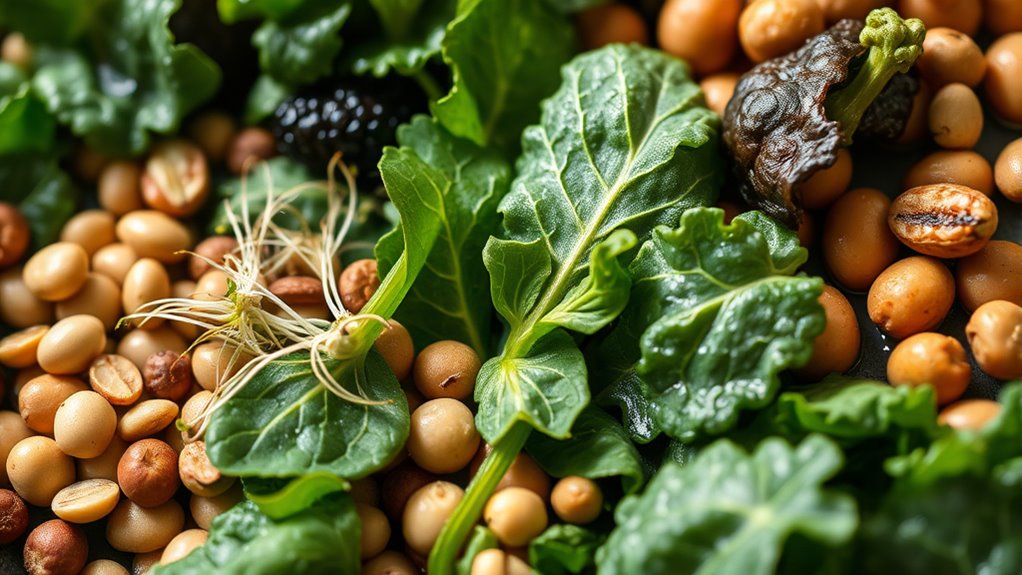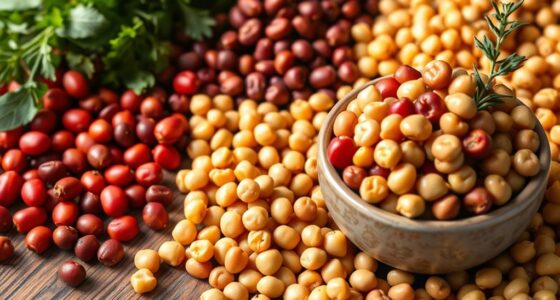Anti-nutrients are natural compounds found in foods like grains, legumes, spinach, and nuts that can interfere with absorbing essential nutrients like minerals and vitamins. To reduce their impact, you can soak, ferment, cook, or sprout these foods, which lowers anti-nutrient levels and boosts nutrient availability. Balancing your diet involves enjoying these foods while minimizing anti-nutrients through proper preparation—keeping your health and nutrition in check is easier than you might think.
Key Takeaways
- Anti-nutrients are natural compounds in foods like grains, legumes, and vegetables that can hinder nutrient absorption.
- Common anti-nutrients include phytates, lectins, and oxalates, which can interfere with mineral uptake and gut health.
- Food processing techniques such as soaking, fermenting, cooking, roasting, and steaming effectively reduce anti-nutrient levels.
- Proper preparation minimizes anti-nutrient effects while preserving the nutritional and health benefits of foods.
- A balanced diet with varied foods and proper preparation helps manage anti-nutrient intake and maximize nutrient absorption.
What Are Anti-Nutrients and Why Do They Matter

Have you ever wondered why some foods can cause health issues despite being nutritious? That’s often due to antinutrients, natural compounds that can interfere with nutrient absorption or digestion. For example, coffee contains antinutrients in coffee that may block minerals like iron and calcium, especially if consumed excessively. Similarly, spices can contain antinutrients in spices that affect your gut health or hinder nutrient uptake. While these compounds aren’t necessarily harmful in small amounts, consuming large quantities or having sensitivities can lead to deficiencies or health problems. Recognizing the presence of antinutrients helps you make better choices and prepare foods in ways that reduce their impact. Understanding anti-nutrient mechanisms can help you develop strategies to minimize their effects while still enjoying nutritious foods. Additionally, food processing techniques such as soaking, fermenting, or cooking can significantly reduce antinutrient levels, making foods safer and more nutritious. Knowing about antinutrient interactions allows for more informed dietary decisions and preparation methods to minimize their effects. Understanding what anti-nutrients are and why they matter empowers you to maintain a balanced, nutritious diet. Awareness of antinutrients allows for more informed dietary decisions and preparation methods to minimize their effects.
Common Types of Anti-Nutrients in Foods
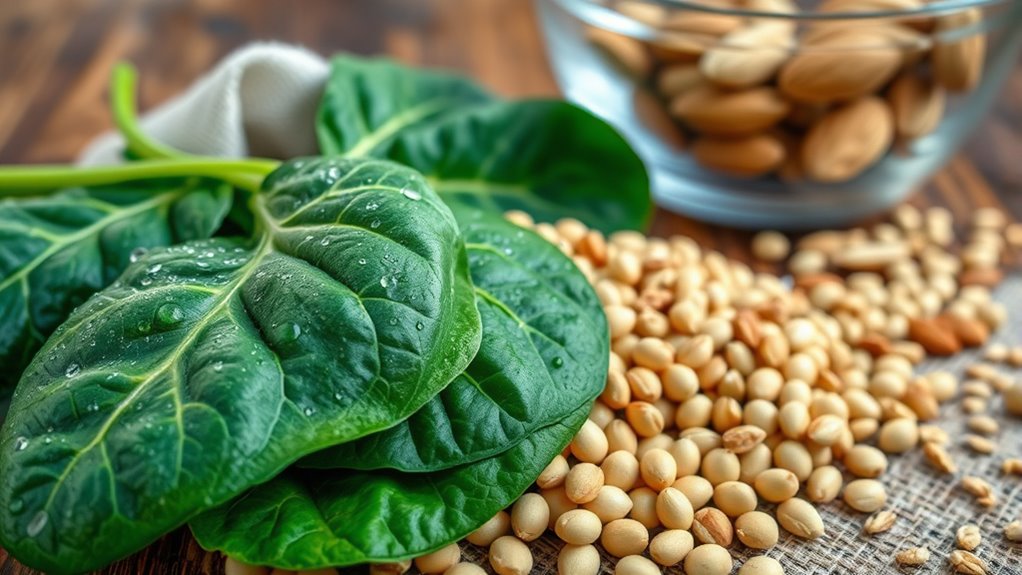
Many of the anti-nutrients you encounter in foods include phytates in grains, lectins in legumes, and oxalates in vegetables. These compounds can interfere with nutrient absorption and affect your health. Understanding how to identify and reduce them helps you make smarter food choices. Engaging with nutritional education can further enhance your understanding of how to mitigate these compounds effectively. Additionally, practicing creative practice techniques such as soaking, fermenting, or cooking foods can help reduce the presence of certain anti-nutrients. As the market growth in AI technology accelerates, new methods and tools are emerging to support healthier eating habits and food safety. Incorporating innovative indoor gardening solutions like unique planters can also promote the cultivation of nutrient-rich foods at home, supporting overall health and well-being.
Phytates in Grains
Phytates, naturally occurring compounds found in grains, can interfere with mineral absorption and potentially impact your nutritional health. To reduce their effects, consider methods like grain sprouting and fermentation techniques, which break down phytates and enhance mineral availability. Sprouting activates enzymes that degrade phytates, making nutrients more accessible. Fermentation, such as sourdough bread preparation, also reduces phytate levels effectively. This process increases nutrient bioavailability and promotes better health outcomes. Additionally, selecting whole grains over refined options can further improve mineral absorption. Here’s how different grains respond:
| Grain Type | Impact of Sprouting & Fermentation | Best Practices |
|---|---|---|
| Wheat & Rye | markedly reduces phytates | Use soaked and fermented methods |
| Barley & Oats | Moderate phytate reduction | Incorporate fermentation techniques |
| Rice & Corn | Limited reduction without sprouting/fermentation | Use sprouted or fermented varieties |
Lectins in Legumes
Legumes are a valuable source of protein, fiber, and nutrients, but they also contain naturally occurring compounds called legumes lectins that can interfere with nutrient absorption and cause digestive discomfort. These anti nutrient impact your gut by binding to intestinal cells and damaging the lining, potentially leading to nausea, bloating, or diarrhea. While cooking methods like soaking, boiling, and fermenting can markedly reduce legumes lectins, it’s essential to prepare legumes properly before eating. Proper preparation is especially important because divorce statistics show that many people may not be aware of the health risks associated with undercooked legumes. Additionally, the presence of cryptic anti nutrients can be reduced significantly through proper processing techniques, ensuring safer consumption. The anti nutrient impact of lectins isn’t necessarily a concern when legumes are cooked thoroughly, but consuming raw or undercooked legumes may pose health risks. Understanding how legumes lectins affect your body helps you make smarter choices and enjoy legume-based foods safely.
Furthermore, being aware of the types of anti nutrients present in foods can help you adopt effective strategies to minimize their effects and improve overall health.
Oxalates in Vegetables
Have you ever wondered why some vegetables can cause health issues despite being nutritious? Oxalates in vegetables are naturally occurring compounds that can contribute to kidney stones and interfere with mineral absorption. To reduce oxalate levels, your choice of cooking methods matters. Boiling vegetables like spinach and beet greens can markedly lower their oxalate content. Steaming or boiling for longer periods helps leach out oxalates into the cooking water, which you should discard. Here’s a quick overview:
| Vegetable | Oxalate Level | Best Cooking Method |
|---|---|---|
| Spinach | High | Boiling, discard water |
| Swiss chard | Moderate | Steaming, boiling |
| Kale | Low | Raw or lightly cooked |
Adjusting your cooking methods can make vegetables safer without sacrificing nutrition. Proper preparation techniques reduce anti-nutrients and support better mineral absorption.
How Anti-Nutrients Affect Nutrient Absorption

Anti-nutrients can interfere with your body’s ability to absorb essential nutrients, making it harder for you to get the full benefits from your diet. They often bind to minerals like calcium, iron, and zinc, reducing their bioavailability. When anti-nutrients such as phytates or tannins are present, they can prevent these minerals from being properly absorbed in your digestive system. This process can also impact soil nutrients, as plants grown in mineral-depleted soils may contain fewer available nutrients, compounding absorption issues. As a result, your body struggles to obtain crucial minerals needed for health. Understanding how anti-nutrients hinder nutrient absorption highlights the importance of processing and preparing foods correctly to maximize mineral bioavailability and ensure your body gets what it needs. Additionally, research in AI Security emphasizes the importance of developing strategies to identify and mitigate anti-nutrient effects in food production and processing. Recognizing the role of food processing in reducing anti-nutrient levels can significantly improve nutrient absorption and overall health.
Foods Rich in Anti-Nutrients to Be Aware Of
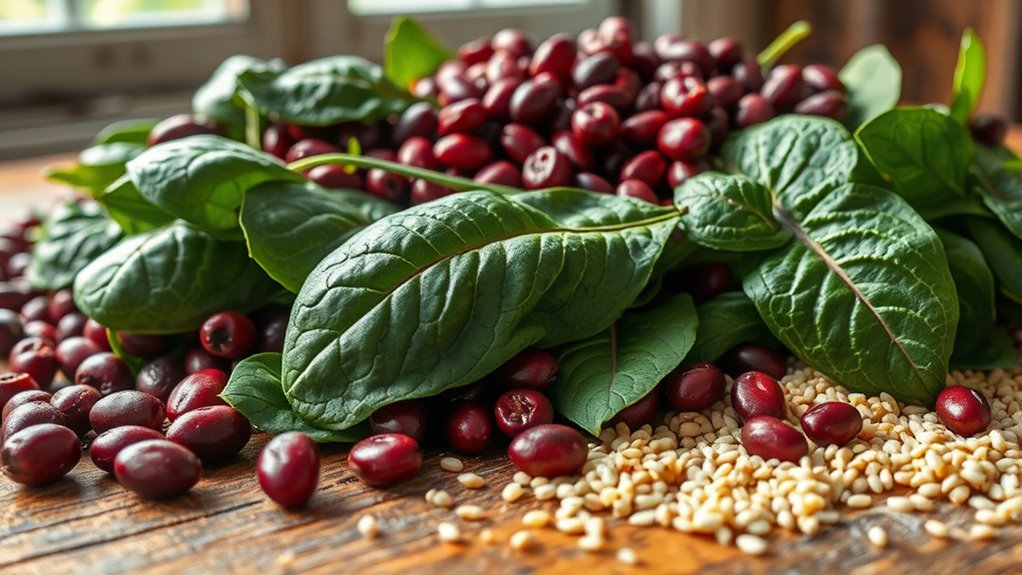
Many plant-based foods contain anti-nutrients that can interfere with nutrient absorption. Common sources include legumes, grains, and certain vegetables like spinach and beets. Being aware of these foods helps you make smarter choices to reduce anti-nutrient intake. Incorporating techniques such as soaking, fermenting, or cooking can also help diminish the levels of anti-nutrients in these foods Glycolic Acid Benefits for Skin. Additionally, understanding how Headphones work can inspire you to adopt efficient methods for maintaining healthy, well-hydrated plants in your home or garden.
Common Anti-Nutrient Sources
Are you aware of which foods are naturally high in anti-nutrients? Many of these come from plant-based sources like grains, legumes, seeds, and nuts. These foods often contain phytates, lectins, and tannins, which can interfere with nutrient absorption. Food processing methods, such as soaking, fermenting, and sprouting, can reduce anti-nutrient levels, but improper culinary techniques may leave them intact. For example, unprocessed beans and whole grains tend to be higher in anti-nutrients, while refined products usually contain fewer. Awareness of these common sources helps you make better choices. Incorporating specific culinary techniques can minimize anti-nutrient content, making these foods safer and more nutritious. Being mindful of food processing and preparation is key to reducing anti-nutrient intake.
Plant-Based Food Risks
Plant-based foods can be rich sources of anti-nutrients that may hinder nutrient absorption and impact health. These risks are often linked to factors like soil contamination, which can introduce harmful substances into crops, and genetic modification, which may alter nutrient profiles or anti-nutrient levels. Being aware of these issues helps you make better choices. For example:
- Some legumes contain phytates that reduce mineral absorption
- Spinach and beet greens have oxalates that block calcium and magnesium
- Seeds and nuts can have enzyme inhibitors affecting digestion
- Crops grown in contaminated soil may contain toxins
- Genetically modified plants might have altered anti-nutrient levels
Understanding these risks enables you to take steps like soaking or cooking foods properly to reduce anti-nutrient content.
The Impact of Anti-Nutrients on Health
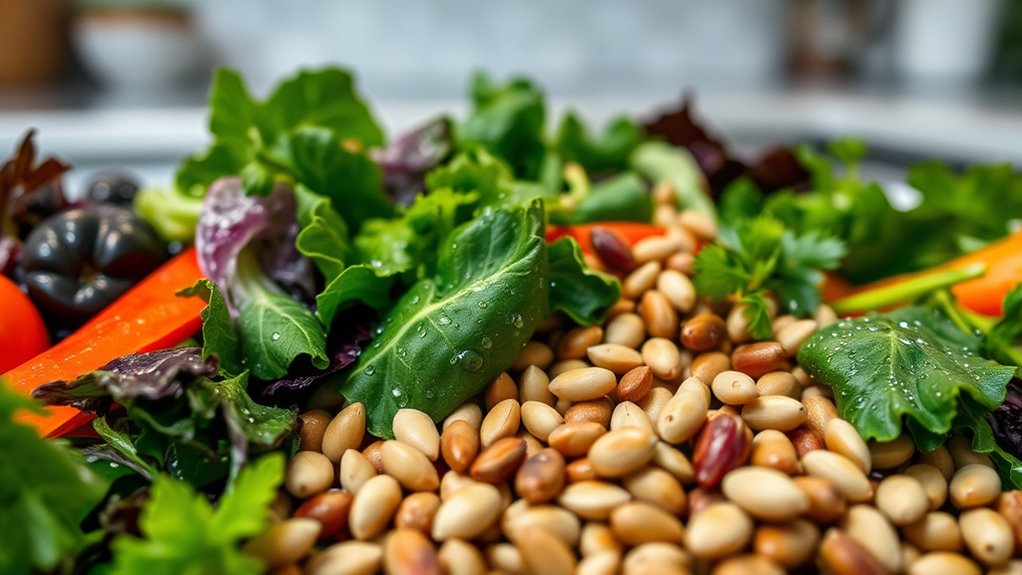
Have you ever wondered how anti-nutrients can affect your health? They can interfere with nutrient absorption, leading to deficiencies over time. For example, phytates hinder minerals like iron and zinc, while lectins can irritate your gut. This impacts your immune system and energy levels. To combat this, antinutrient detox methods help minimize their effects, supporting better nutrient uptake. Here’s a simple overview:
| Anti-Nutrient | Effect on Health | Mitigation Strategy |
|---|---|---|
| Phytates | Mineral deficiencies | Soaking, sprouting, fermenting |
| Lectins | Gut irritation | Cooking thoroughly |
| Oxalates | Kidney stones risk | Boiling, reducing intake |
Understanding these impacts helps you make smarter choices for maintaining optimal health.
Practical Methods to Reduce Anti-Nutrient Levels

To effectively reduce anti-nutrient levels in your diet, implementing practical processing techniques can make a significant difference. You can lower compounds like phytates and oxalates by using specific cooking methods and fermentation techniques. For example, soaking grains or legumes overnight helps activate enzymes that break down anti-nutrients. Cooking methods such as boiling, steaming, or roasting can also diminish anti-nutrient content while preserving nutrients. Fermentation techniques, like making sourdough bread or fermenting vegetables, further reduce anti-nutrients and boost nutrient absorption. Consider these practical tips:
Reducing anti-nutrients with soaking, cooking, and fermentation boosts nutrient absorption and improves your diet.
- Soak beans and grains before cooking
- Use boiling or steaming instead of raw consumption
- Ferment vegetables or grains regularly
- Roast nuts to lower phytates
- Incorporate sprouting into your preparation routine
These approaches help you enjoy nutrient-rich foods with fewer anti-nutrients.
Balancing Anti-Nutrient Intake With Nutritional Benefits
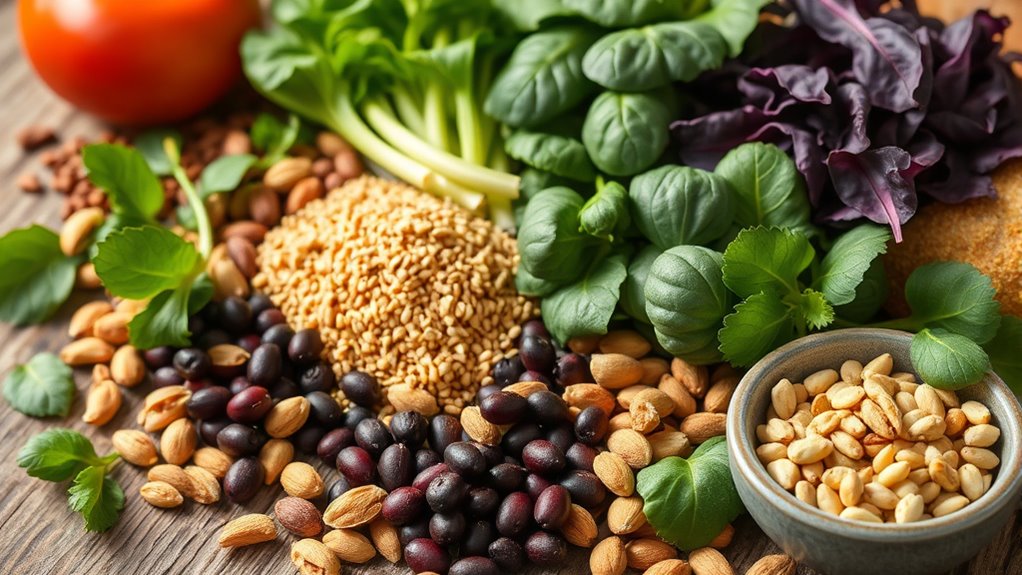
While anti-nutrients can interfere with mineral absorption, it’s important to recognize that many foods containing these compounds also offer essential nutrients and health benefits. To balance anti-nutrient intake with nutritional benefits, you should focus on strategic dietary planning. Incorporating variety ensures you get enough nutrients while minimizing anti-nutrient effects. For example, soaking or cooking foods like beans reduces phytates, enhancing nutrient absorption without eliminating benefits. Here’s a quick guide:
| Anti-Nutrient | Food Sources | Nutritional Benefit |
|---|---|---|
| Phytates | Legumes, grains | Fiber, minerals |
| Oxalates | Spinach, nuts | Antioxidants, calcium source |
| Tannins | Tea, coffee | Antioxidants, digestive health |
| Lectins | Beans, lentils | Protein, fiber |
Balancing these elements through thoughtful dietary choices improves nutrient absorption and sustains health.
Tips for Incorporating Anti-Nutrient-Reducing Techniques in Your Diet
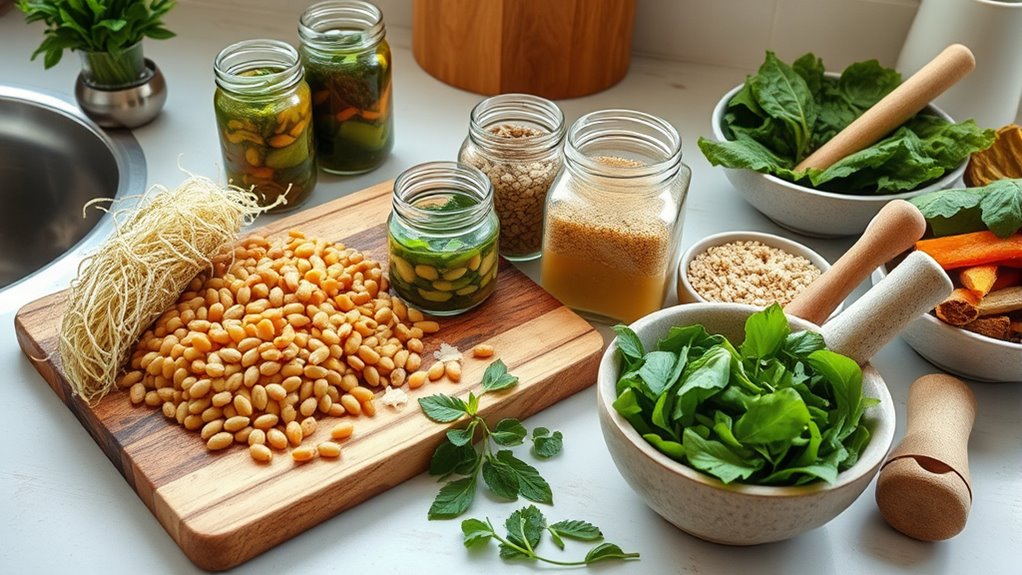
Incorporating anti-nutrient-reducing techniques into your diet can considerably boost nutrient absorption and overall health. Start by choosing cooking methods that minimize anti-nutrients, such as soaking, boiling, or fermenting foods like legumes and grains. Food pairing also plays a role; combining vitamin C-rich foods with iron-containing plant foods enhances mineral absorption. Additionally, sprouting seeds and grains can decrease anti-nutrient levels naturally. Incorporate these tips into your routine to optimize nutrient intake. Consider these strategies:
- Use soaking or sprouting before cooking grains and legumes
- Opt for boiling or fermenting foods instead of raw consumption
- Combine citrus fruits with iron-rich plant foods for better absorption
- Avoid overcooking, which can destroy nutrients
- Rotate different food sources to prevent buildup of anti-nutrients
These simple adjustments can make a big difference in your diet’s nutrient quality.
Frequently Asked Questions
Can Anti-Nutrients Be Completely Eliminated From Foods?
Anti-nutrients can’t be completely eliminated from foods because they naturally occur in many plant-based foods. While processing can reduce their levels, some will always remain, impacting how your body absorbs nutrients. You might think removing them entirely is possible, but that’s not realistic. Instead, focus on proper preparation methods, like soaking or cooking, to minimize their dietary impact and enjoy a balanced, nutrient-rich diet.
Are There Specific Populations More Affected by Anti-Nutrients?
You might not realize, but vulnerable populations and those with genetic predispositions are more affected by anti-nutrients. While healthy individuals often tolerate them well, pregnant women, children, and people with certain health conditions face higher risks. Their bodies struggle to process anti-nutrients, making it harder to absorb essential nutrients. Recognizing this helps you understand why some groups need extra care and tailored dietary choices to stay healthy.
How Do Cooking Methods Influence Anti-Nutrient Levels?
Cooking techniques play a key role in reducing anti-nutrient levels and preserving nutrients. You can use methods like boiling, soaking, or fermenting to decrease anti-nutrients such as phytates and oxalates, which hinder mineral absorption. Steaming and pressure cooking also help retain nutrients while lowering anti-nutrient content. By choosing proper cooking techniques, you optimize nutrient preservation and make your foods healthier, ensuring you get the most benefit from your diet.
Are Anti-Nutrients Present in Processed or Packaged Foods?
You might wonder if anti-nutrients are in processed or packaged foods. While some food additives can act as anti-nutrients, many processed items contain anti-nutrients naturally from ingredients like soy or grains. These anti-nutrients can hinder nutrient absorption, but cooking and processing often reduce their levels. Always check labels, and choose minimally processed foods to support better nutrient absorption and avoid unnecessary anti-nutrients.
Can Anti-Nutrients Have Any Health Benefits?
Anti-nutrients might seem harmful, but they can offer health benefits too. They can help regulate nutrient absorption, preventing excessive intake that might lead to issues like nutrient imbalance. Additionally, some anti-nutrients, such as phytochemicals, can promote disease prevention by acting as antioxidants. So, in moderation, anti-nutrients can contribute to a balanced diet and support overall health without compromising your body’s functions.
Conclusion
Think of anti-nutrients as shadows lurking in your favorite foods. While they can block some nutrients, your mindful choices act as the guiding light, illuminating a balanced diet. By understanding and reducing anti-nutrients, you’re steering your health ship safely through potential storms. Remember, moderation and preparation are your compass—helping you enjoy the nourishing sunbeams of wholesome foods without the shadows. Your journey to health is a dance of light and shadow—find harmony.
Aurelia is the Editor-in-Chief of The Graceful Kitchen, a vegan lifestyle blog that focuses on delicious, nutritious, and ethical eating. A lifelong vegan, Aurelia is passionate about sharing her love of plant-based cuisine with others. She is a regular contributor to several online and print publications, and has been interviewed by major news outlets about the benefits of a vegan diet. In her free time, Aurelia enjoys cooking, hiking, and spending time with her cats.
